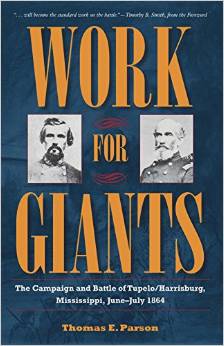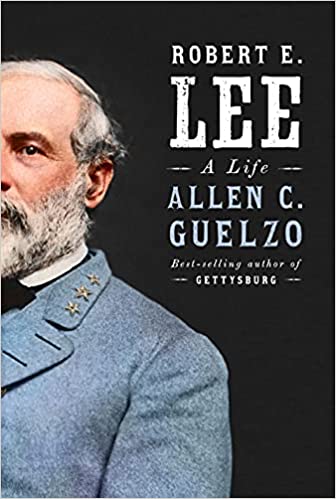Work for Giants: The Campaign and Battle of Tupelo / Harrisburg, Mississippi, June-July 1864 by Thomas E. Parson. Kent State University Press, 2014. Cloth, ISBN: 978-1-60635-222-9. $39.95.
 The Tupelo Campaign offers a study in contrasts. Waged in northeastern Mississippi in 1864, it was far removed from the clashes of armies outside Richmond and Atlanta, yet the campaign benefitted the Union drive against the latter city. It pitted Union forces against the seemingly invincible Nathan Bedford Forrest, yet it saw the federals hand him his first significant defeat. The Battle of Tupelo (or Harrisburg) by almost any objective standard counted as a Union victory, yet after the war Confederate veterans tried to recast it as a triumph for Southern arms. These are among the stories that Thomas E. Parson, a National Park Service ranger at the Corinth Civil War Interpretive Center (part of Shiloh National Military Park), tells so skillfully in Work for Giants.
The Tupelo Campaign offers a study in contrasts. Waged in northeastern Mississippi in 1864, it was far removed from the clashes of armies outside Richmond and Atlanta, yet the campaign benefitted the Union drive against the latter city. It pitted Union forces against the seemingly invincible Nathan Bedford Forrest, yet it saw the federals hand him his first significant defeat. The Battle of Tupelo (or Harrisburg) by almost any objective standard counted as a Union victory, yet after the war Confederate veterans tried to recast it as a triumph for Southern arms. These are among the stories that Thomas E. Parson, a National Park Service ranger at the Corinth Civil War Interpretive Center (part of Shiloh National Military Park), tells so skillfully in Work for Giants.
Union forces had already attempted two previous forays into northeastern Mississippi, including one that had been thwarted by Forrest’s stunning victory at Brice’s Crossroads. The federal high command sought to pin down the “Wizard of the Saddle,” preventing him from attacking Sherman’s supply lines through Tennessee and Georgia. Parson faults Jefferson Davis for taking the bait and ordering Forrest to resist the Union foray, rather than heeding the calls of Georgia Governor Joseph Brown to send all available forces to protect his own state.
As with a number of campaigns in secondary theaters of the war, both the Union commander and his troops—General A. J. Smith and the two divisions of his 16th Corps—had been shuttled across the map to various trouble spots during their service, so much so that Smith referred to his corps as “the Lost Tribe of Israel.” As for the men themselves, they reveled in the nickname “Smith’s Gorillas,” an appellation that bespoke their grubby campaign-worn uniforms and often-unruly attitude toward military discipline (as well as their fighting qualities). The Union column would also include a brigade of United States Colored Troops, men eager to avenge their brothers-in-arms slaughtered at Fort Pillow by Forrest’s troopers. Andrew Jackson Smith, West Point class of 1838 and a career soldier, is not the most familiar figure in the Civil War’s cavalcade of generals, an obscurity due in part to the fact that he did not leave behind the voluminous writings that his fellow generals did. Parson presents Smith as solid, capable soldier, one who earned his victories in the Tupelo Campaign by learning from his predecessors’ mistakes.
In June 1864, Smith’s force launched their expedition into Mississippi under a relentless summer sun. Smith and his men met the Confederate main body on July 14 at Harrisburg, a town that had lost much of its population and commerce since the railroad came to nearby Tupelo. The battle pitted some 14,000 federals against no more than 9,600 Confederates. Though outnumbered, Confederate commander Stephen D. Lee (outranking Forrest) decided to assault the Union left. Lee’s plan devolved into a series of piecemeal attacks, however, punctuated by a brigade of Kentucky infantry directly attacking the Union center, only to be shattered by the defenders’ musketry. Parson describes the fighting in gripping detail—a battle that went poorly for the Rebels. That night, Forrest launched an attack aimed at surprising and outflanking the Union left under the cover of darkness. Unbeknownst to Forrest, Smith had drawn in his left, ironically because he assumed the Rebels were ignoring that flank. Instead of pouncing on sleeping Yankees, Confederate troopers found only Union skirmishers. A night battle erupted, in which the skirmishers’ comrades arrived to repulse the enemy cavalry.
Despite having won the day (and night), A. J. Smith elected to withdraw. It was a case of “for want of a nail,” and the campaign was cut short. Parson establishes that there were very real problems with the federals’ supplies, the reason Smith cited for the retreat. Much of the soldiers’ hardtack was spoiled and vermin-infested (presumably worse than usual), the artillery was short of ammunition, and some of the infantry had been issued cartridges with impure gunpowder—ostensibly the work of an unscrupulous supplier. Parson also notes, quite reasonably, that these were problems Smith and his subordinates could have avoided through more careful planning and inspections before the campaign. Two more skirmishes followed on the march back into Tennessee, both in which the federals prevailed. Despite conducting what one Indiana solider called a “backward march,” Union troops felt justifiably successful at the campaign’s close, having met the enemy and, as Smith described, “whipped them badly on three different days.”
Parson’s final chapter describes the postwar battle over just who had really won the Tupelo Campaign. He demonstrates that Smith and his men, in keeping Forrest out of Sherman’s hair and tactically defeating the Confederates, had clearly prevailed. Inspired by the Union retreat, however, Confederate veterans tried to claim victory after the war, partially to defend Forrest’s reputation, and partially because they misunderstood the federal objectives. In this cogently argued chapter, Parson lays out the narrative of Confederate victory and dismantles each argument point-by-point. For instance, Confederates believed they had prevented Smith from despoiling Mississippi’s rich Black Prairie region, but this had never been Smith’s objective.
Work for Giants stands out as a model work of well-written, well-researched military history. Parson takes readers through the Tupelo Campaign’s inception, conduct, and execution with a thorough study of the battles and skirmishes, and concludes with an authoritative analysis of the results and how participants and historians have remembered and argued over it. He also offers rich personalized descriptions of the key players on each side, giving life to the common soldiers’ experiences in their own words. The book itself is a handsome volume with photographs and illustrations (including soldiers’ art) interspersed throughout. Notably, it also features nearly a dozen detailed campaign and battle maps by Dave Roth of Blue & Gray Magazine, many illustrated down to the regimental level.
This is the second book in Brian Steel Wills’ “Civil War Soldiers and Strategies” series. If subsequent volumes are as impressive and well crafted as Thomas E. Parson’s study of the Campaign and Battle of Tupelo/Harrisburg, then it bodes very well for the series.
Jonathan M. Steplyk is a Ph.D. candidate in History at Texas Christian University and has also worked as a seasonal ranger at Cedar Creek and Belle Grove National Historical Park.

